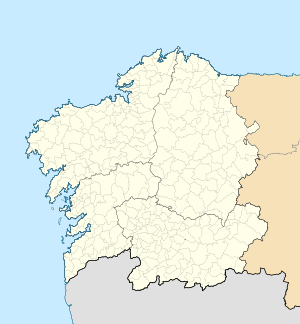AVE viaduct over the Río Ulla (Eje Atlántico)
Coordinates: 42 ° 40 ′ 9 ″ N , 8 ° 43 ′ 59 ″ W.
| AVE viaduct over the Río Ulla | ||
|---|---|---|
| use | High speed traffic | |
| Convicted | Eje Atlántico de Alta Velocidad | |
| Crossing of | Rio Ulla | |
| place | Catoira | |
| construction | Composite steel bridge | |
| overall length | 1621 m | |
| width | 14 m | |
| Number of openings | twelve | |
| Longest span | 240 m | |
| completion | 2015 | |
| planner | IDEAM | |
| location | ||
|
|
||
The AVE viaduct over the Río Ulla ( Spanish Viaducto sobre el Río Ulla en el Eje Atlántico ) is just before the mouth of the Ulla in the Ría de Arousa bay between the province of A Coruña and the province of Pontevedra in the Spanish autonomous region of Galicia . The double-track railway bridge is part of the high-speed line of the Atlantic Axis ( Eje Atlántico ) of the Alta Velocidad Española (AVE) from Santiago de Compostela to Pontevedra .
The AVE viaduct over the Río Ulla des Eje Atlántico is not to be confused with the Viaducto del Río Ulla , a concrete arch bridge that crosses the river on the AVE route from Santiago de Compostela to Ourense .
The AVE viaduct opened over the Río Ulla in 2015, with a maximum span of 240 m, is the widest- span railway girder bridge in the world and has thus replaced the main valley bridge in Nantenbach .
The viaduct took second place in the 2016 Outstanding Structure Award from the International Association for Bridge and Structural Engineering (IABSE).
description
The steel truss composite bridge has a length m of 1621, 11 of reinforced concrete - pillar with center distances of 50 + 80 + 3x120 + 225 + 240 + 225 + 3x120 + 80 m. The five middle fields have haunched girders with a construction height of 17.90 m on the four central pillars and 9.15 m in the middle of the field or on the outer supports. The girders of the outer fields have a constant height of 9.15 m.
The four central pillars are rigidly connected to the truss girders of the three central fields, with which they form a frame . The upper straps of the trusses are connected to a laterally cantilevered, 14 m wide concrete slab that carries the ballast bed for the tracks and two narrow paths for the maintenance staff. A concrete slab of variable thickness is inserted between the lower chords, which takes on static tasks near the pillars, but in the middle of the field is only used for inspection and maintenance.
The steel components of the truss were manufactured in four different plants in northern Spain and welded to larger units in temporary halls on the construction site. As tunnels were being built at both ends of the future bridge, there was no space for a conventional incremental launching method . Therefore, the trusses were first prepared on a building site in the first two openings, then lifted onto auxiliary supports and moved over the next fields. On the opposite side with an even slope, the girders were prepared on the ground and then lifted and connected with truss parts on the pier heads to form a continuous girder . The girders over the large central openings were created in sections using the classic cantilever structure .
Finally, the lower concrete slabs were concreted with formwork attached to the girders. For the roadway, precast concrete parts were first used, on which a layer of in-situ concrete was applied.
The bridge was planned by IDEAM, built by a joint venture between Dragados and TECSA and opened in 2015 together with Eje Atlántico .
literature
- Pruebra de carga del viaducto sobre el Río Ulla - final exam. In: Fomento , Revista del Ministerio de Fomento, March 2015 Nº 648, pp. 18-22
- Francisco Millanes Mato, Miguel Ortega Cornejo, Rubén A. Estévez Sánchez: Viaduct over Ulla River in the Atlantic High Speed Railway Line: A composite (steel-concrete) truss world record. In: Hormigón y Acero , Vol 66 No 277, 2015
Web links
- Ulla Estuary Viaduct on IDEAM.es
- Viaducto sobre el río Ulla en España: Luces de 225 m on construccionyvivienda.com
- Viaduct over the River Ulla, Spain on iabse.org
- Viaducto del río Ulla (Eje Atlántico) on ferropedia.es
Individual evidence
- ^ The Outstanding Structure Award
- ↑ Ulla Estuary Viaduct on IDEAM.es
- ↑ Viaducto del Río Ulla on Dragados.com

